
1999 Living Room Layout. Kinda small, huh?
Instead, I have many layouts, each one gets set up, played with and then taken down relatively quickly. I keep my trains in boxes, but I pull them out at least once a year and set them up around my Christmas Tree, and from time to time I set them up on the floor somewhere and leave them for a day or a month or...

I built this Pike in 1999 simply as a way of seeing what I have, and sharing it with my friends. And it turned out to be a big hit! Everyone wanted to play with the trainset. Some of my roommates and friends thought I was a bit nuts, but everyone loved it. Particularly when I showed them how to use all those Transformers and Control Panels down in the lower left-hand corner. I'm talking Adults here, trendy NY Actor types and Professionals and Neighbors. I live smack in the middle of New York City, in Manhattan.
My Friends are all very sad that took it down... (Sorry, Mindy and Donna.) It took up the whole floor, and was about 10 feet by 6 feet. I had it up for about 2~3 months before it just had to come down.
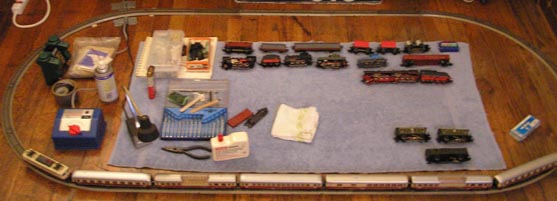
Note how all the cars are laid out on a towel, and the Engines and cars with lights are on their sides to protect the pickup shoes. Also note the large LGB Smoke Oil bottle on the left next to all the tools. Finally note the weird Green Binocular Thingy in the upper left inside the oval. That is a Konami Combat-DigiQ Infrared Controlled WWII Panther Tank mounted on its Controller, which is almost to scale with the trainset. Can anyone say Panzerkampfwagen Funf? ;)
[TK -- C Track Layout Shots]
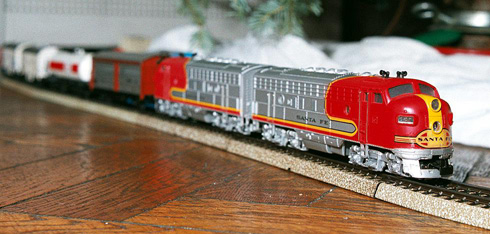
The layout on the right is from last Christmas (as of this writing), and managed to entertain several friends from around the world. But I've been putting up layouts around my tree for almost every year since I got it.
When I was a kid, my oldest friend Bob Rowe used to love my christmas layouts, because I'd bent a lot of my track, and the train kept falling off. "I love your trains Mark, they have accidents just like real life." I guess I won't get too much for the old passenger train on eBay... Oh, Harold Van Aalderen took that shot with his pocket ditigal camera.
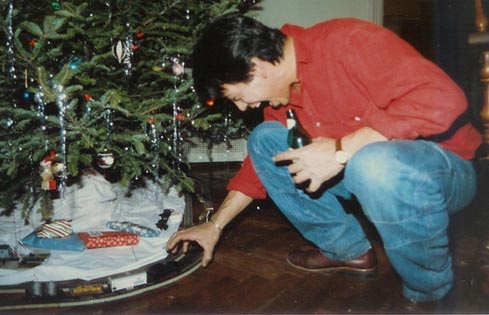
The Gentleman (???) attacking the train on the left is my good friend Maurice Castro, who at the time was a Chef for Louie's Westside Cafe, a very trendy and expensive restaurant up here on the West Side of Manhattan. This is from a Christmas party back in the late 1980s.
See how Maurice has been captured in a moment of destructive infantile joy? Normally Maurice is very reserved and proper, but pour a little Heinekin in him and this is what you get. All in all a trainset around your tree is going to liven things up a bit, along with the beer.
You can't see it from this shot, but that layout had two ovals and electric switches, and could run two trains.
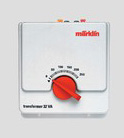
It gets boring watching the train go around and around on a single oval of track, so you get more track and expand the layout to make it more interesting. This usually means switches, and with switches another oval, and then you can send the train from one track to another, usually by flipping a lever on the switch.
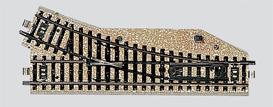
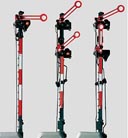
You probably also have some more rolling stock, including passenger and frieght cars, and maybe another engine. And you think "What if I could keep all this on the layout, and hook up the cars into different trains? And maybe switch the engine on a train to a different one?" This is when you decide to build a Yard where you can park all the stuff, and an uncoupling track so you can switch cars on your trains.

I hope you haven't looked at how much all this cost by now, because you're probably out at least several hundred bucks, regardless of what type of train you're playing with. You're also learning the hard way about track wiring, isolated track, ground, and if you're playing with an AC set, transformer polarity.

This is nothing compared to what you end up with when you build a permanent layout. Most hobbyists end up designing their own Control Panels with a diagram of the layout and lights to match the real panels used in Signal Towers on real train systems.
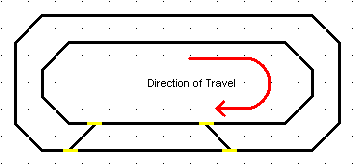
Imagine you have two trains, one on each oval, both running in the same direction. Now imagine you just lean over and flip one of the switches so the inside train goes on the outside track. In about 30 seconds, you get BOOM as one train collides into the other, because the engines run at different speeds, so the train following rams the train in front. Kind of exciting (in a Gomez Adams way) the first few times, but rather expensive and annoying in the long run.
Of course, my Mad Plan was to get the two trains to control each other, so there would be no BOOM. To do that, you need a signal, and some track to sense where the trains are. The Signal "holds" one train in a "dead section", until the other train reaches a point where it is safe to "let it go". What follows is for real Gear Heads...
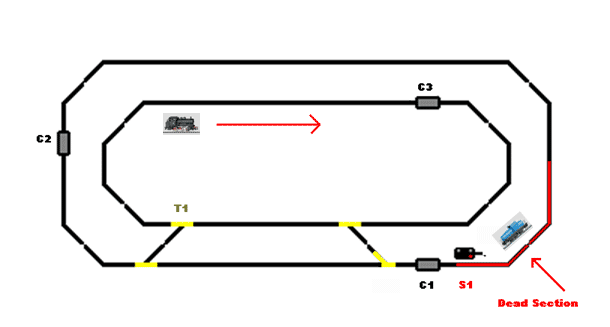
When the Black Engine passes over Contact Track C3, it switches Turnout T1 to curved, to send the Black Engine to the outside. The Black Engine then leaves the inner oval.
Then, when the Black Engine passes over Contact Track C2, it switches Turnout T1 back to straight. It also turns on Signal S1, to let the Blue Engine in the Dead Section go. The Blue Engine runs onto the inner oval.
Immediately after leaving the Dead Section, the Blue Engine passes over Contact Track C1, turning the Signal back off to catch the Black Engine, which is now running up the outer oval.
By the way, there are many problems with this solution, as anyone who has tried this knows. For example, if the Black Engine is running very slowly (maybe because of Cat Hair in the gearing?) then the Blue Engine will pass into the inner oval, go around it once and pass over Contact Track C3 (switching Turnout T1 back to curved), pass back out to the outer oval and ram the Black Engine from behind before it can get to Contact Track C1 to turn the Signal off and catch the Blue Engine in the Dead Section again. More BOOM.
This kind of train control has been common on both European and American layouts since before World War II. Setting up layouts like this has taught countless kids not only basic electronics, but basic programming as well. And its probably scared the hell out of countless Cats, the trains seem to be displaying intelligence as they stop and start each other with that Signal.
Oh, thanks to Holger Seider and his Railyplan software. I used it to help make these diagrams, and to experiment with Computer Train Control (see below).